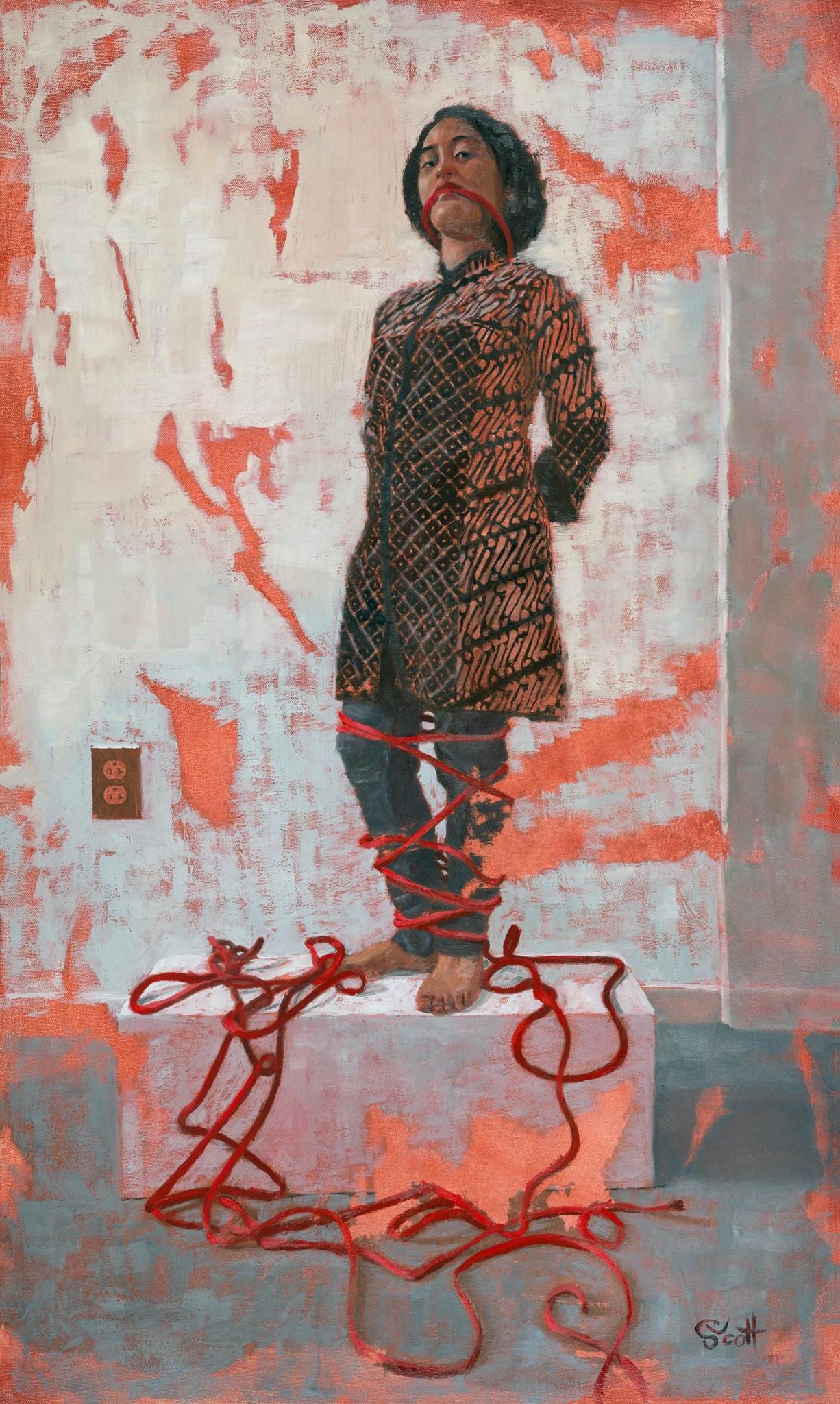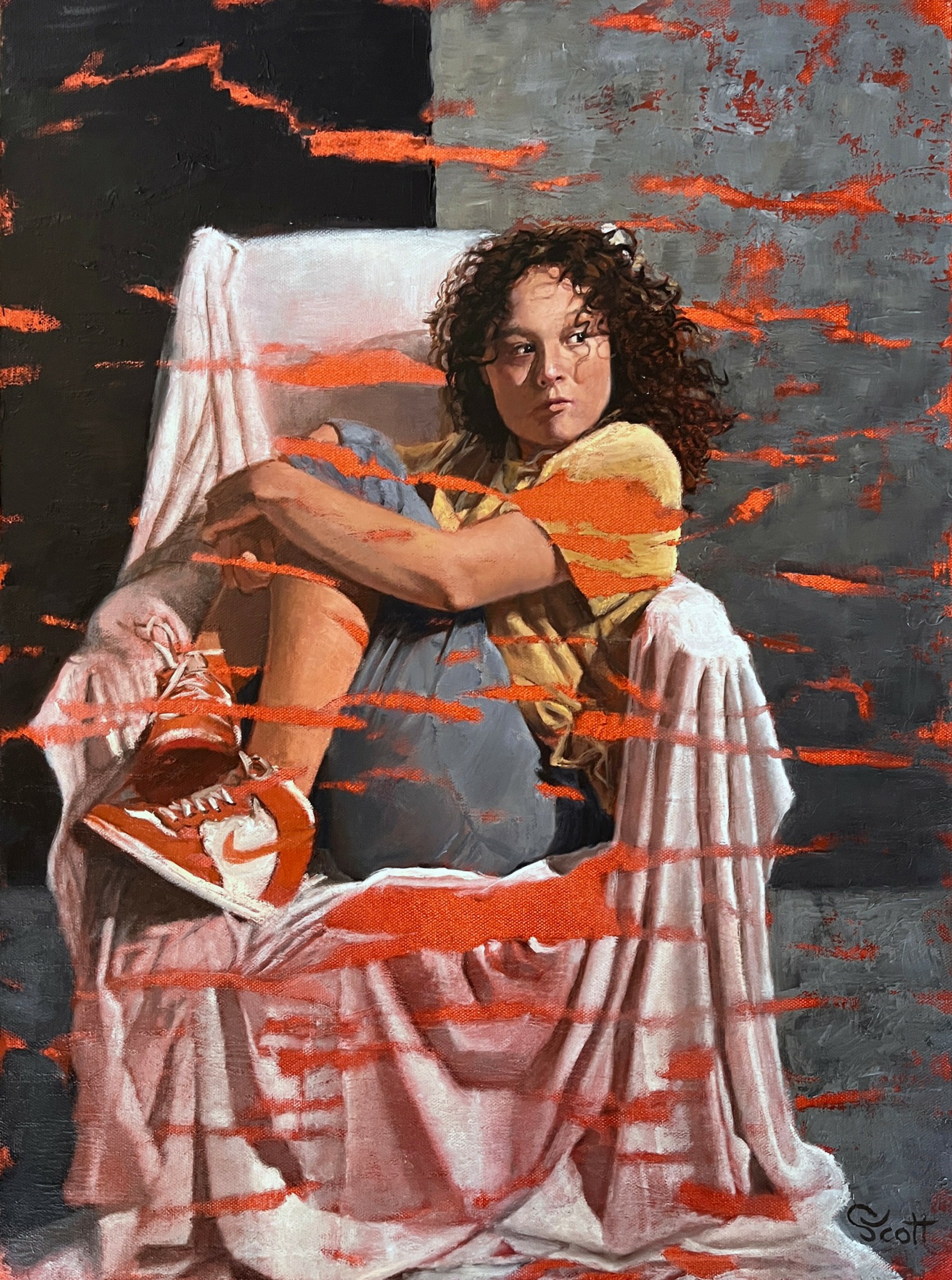We caught up with the brilliant and insightful Deborah Scott a few weeks ago and have shared our conversation below.
Alright, Deborah thanks for taking the time to share your stories and insights with us today. We’d love to hear about a project that you’ve worked on that’s meant a lot to you.
It’s hard to choose just one, but there’s a painting that still lingers for me.
I was working with a woman who’d lived through a kind of loss that didn’t have a clear name—something unspoken in her family, never quite acknowledged. When we started talking, she didn’t want to tell the full story. She just offered fragments. Images. Phrases. I didn’t push. I painted from what she gave me—and what she didn’t.
The final piece doesn’t depict an event or even a memory. It holds a tension. There’s weight in the posture, in the color choices, in what’s been left unsaid. When she saw it, she started crying—but not because it was sad. She said, “It doesn’t explain anything. But it feels true.”
That moment—that’s why I paint. Not to explain or document, but to make space for something someone’s carried alone for too long.
It wasn’t a public commission or a big gallery piece. But it reminded me that sometimes the most meaningful projects don’t happen in front of an audience. They happen in the space between two people, and the work becomes the third presence in the room.

Deborah, before we move on to more of these sorts of questions, can you take some time to bring our readers up to speed on you and what you do?
About Me & My Work
I am Deborah Scott, a contemporary painter and the originator of Structural Omission, a framework in contemporary realist painting.
Before becoming a full-time artist, I worked in global brand marketing. I spent years distilling what people feel but can’t quite say. Now I do the same thing with paint. Each piece starts with a conversation—real, human, often messy. I listen for the things people hesitate to say outright. That’s where the painting begins.
The work itself blends classical technique with intentional disruption. There’s always a figure, sometimes a clear likeness—but what I’m really after is the tension. The weight. The emotional and psychological presence that sits underneath what we show to the world. That’s why I describe my work as “disrupted realism.” It looks familiar, but it doesn’t resolve cleanly. Because the full story doesn’t exist—and pretending it does is a lie I’m not willing to paint.
What I Offer
I work on both independent paintings and commissioned pieces—but I don’t do traditional portraiture. If someone wants a flawless likeness to hang above their mantel, I usually recommend someone else.
But if they’re looking for something more raw, more revealing—something that holds both what’s said and unsaid—I’m all in. The people I paint aren’t looking for validation. They’re looking for reflection. And I build that with them, layer by layer.
I also write. I’m currently publishing essays about the ethics of using others’ stories in contemporary art—what we owe the people who let us in, and how we carry those narratives forward without flattening them.
What I’m Proud Of
I’ve shown in galleries and museums across the U.S. and Europe, been selected for competitive residencies, and had my work recognized by curators and collectors. But honestly, what I’m proudest of is when someone sees themselves in a painting and says, “I’ve never seen that part of me before—but it’s real.”
That moment of recognition, without simplification—that’s the goal. Every time.

Is there a particular goal or mission driving your creative journey?
Yes—there is. My work is built around one central idea: the full story doesn’t exist.
That might sound a little abstract, but it plays out in very real ways. I paint people who’ve shared moments from their lives with me—sometimes intimate, sometimes unresolved—and I build from those stories. But I don’t try to explain them. I’m not after neat conclusions.
Instead, I create visual spaces that hold both what’s known and what’s unknowable—what someone can tell you, and what they can’t quite put into words. The result is a portrait that’s not just about how someone looks, but about what they carry.
Lately, this idea has also shaped my writing. I’ve been exploring the ethics of using personal stories in art—especially when those stories belong to someone else. It’s part of a broader project I’m developing through essays and painting that asks: what do we owe the people who let us in?
So yes, there’s a mission. But it’s not about self-expression for the sake of it. It’s about making work that resists simple answers and honors what we don’t fully understand. And sometimes, the best thing a painting can do is leave space for what isn’t visible—but still felt.

Is there something you think non-creatives will struggle to understand about your journey as a creative?
Oh, absolutely. Most non-creatives assume that because I paint people, I must be trying to “capture their soul” or “tell their story.”
Spoiler: I’m not. At least not in any clean, poetic way.
What I’m really doing is trying to paint what can’t quite be said—the static around the signal, the feeling that something’s off or unfinished or hiding just outside the frame. It’s not about clarity. It’s about tension. Psychological friction. Narrative ambiguity.
That’s the part non-creatives often struggle with. We’re taught to expect art to reveal, resolve, or explain. I’m more interested in what it refuses to tell you.
So if you look at one of my paintings and feel like something’s missing or off-kilter… good. That’s not a flaw. That’s the design.
Art doesn’t need to wrap things in a bow. Sometimes it’s better to leave the ribbon untied and let the contents spill out a little.
Contact Info:
- Website: https://www.deborahscottart.com
- Instagram: https://www.instagram.com/deborahscottart/





